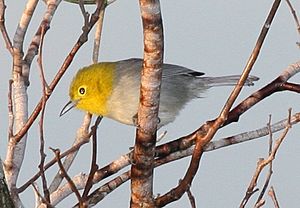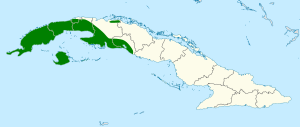Yellow-headed warbler facts for kids
The yellow-headed warbler (scientific name: Teretistris fernandinae) is a small, colorful bird found only in western Cuba. It belongs to the Cuban warbler family, which has just two species. This means you can only find this special bird in Cuba!
Quick facts for kids Yellow-headed warbler |
|
|---|---|
 |
|
| Conservation status | |
| Scientific classification | |
| Genus: |
Teretistris
|
| Species: |
fernandinae
|
 |
|
| Teretistris fernandinae range | |
Contents
Bird Families: How Birds Are Grouped
The yellow-headed warbler is in the same bird family and group (genus) as the Oriente warbler. These two birds were once thought to be part of a larger group called New World warblers.
However, scientists studied their DNA. This helped them understand how different bird species are related. In 2017, the Cuban warblers were given their own special family. Their closest relatives include birds like the yellow-breasted chat.
The yellow-headed warbler is a "monotypic" species. This means it does not have any different subspecies or types within its own species.
What Does the Yellow-headed Warbler Look Like?
This bird is about 13 centimeters (5 inches) long. It weighs between 6 to 18.5 grams (0.2 to 0.65 ounces).
Its whole head is bright yellow. The top of its head and neck have a slight olive-green color. Its back and upper parts are gray. The feathers on its belly are a lighter grayish-white.
Where Does the Yellow-headed Warbler Live?
The yellow-headed warbler lives in the far western part of mainland Cuba. You can also find it on Isla de la Juventud (Isle of Pines) and nearby Cayo Cantiles.
It lives in many different types of forests. It prefers places where the plants on the forest floor are not disturbed. It also lives in scrubby, bushy areas that are drier. This bird can be found from lowlands all the way up to high mountains.
Yellow-headed Warbler Behavior
Movement and Home
The yellow-headed warbler stays in the same area all year long. It does not migrate to other places.
What Does the Yellow-headed Warbler Eat?
This bird looks for food from the ground up to the middle parts of the forest. It picks insects and other small creatures off rocks and leaves. Scientists also believe it eats small lizards. Yellow-headed warblers often look for food together in groups.
Reproduction and Life Cycle
The yellow-headed warbler's breeding season is from March to July. The eggs are usually laid in April and May.
It builds a cup-shaped nest using grass, small roots, and other plant materials. The nest is usually placed low in a bush, vine, or small tree. A female bird usually lays two or three eggs. We don't know how long the eggs take to hatch or how long it takes for the young birds to leave the nest.
What Does the Yellow-headed Warbler Sound Like?
The song of the yellow-headed warbler is a series of buzzing, scratchy notes. These notes are mixed with sweeter, more musical sounds.
Its calls include a fast, high-pitched, short chattering sound. It also makes other buzzing and scratchy noises.
Yellow-headed Warbler Status
The IUCN (International Union for Conservation of Nature) has looked at the yellow-headed warbler. They have assessed it as "Least Concern." This means it is not currently in danger of disappearing.
It lives in a small area, and we don't know exactly how many there are. However, its population is thought to be stable. There are no immediate threats that scientists have found. People consider it common to very common in the places where it lives.
See also



